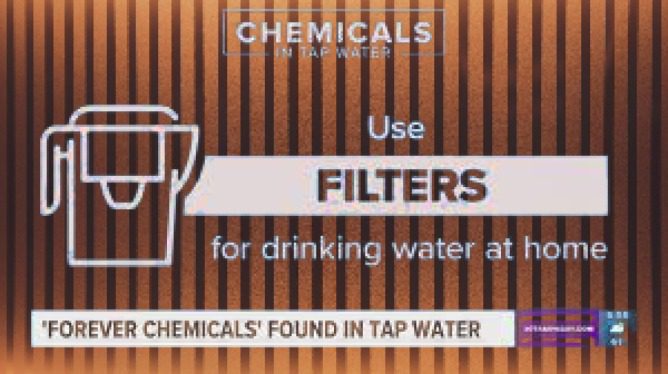Forever Chemicals Found in the US: In a concerning revelation, a recent study conducted by the U.S. Geological Survey (USGS) has shed light on the presence of per- and polyfluorinated alkyl substances (PFAS), commonly known as “forever chemicals,” in the tap water of the United States. The findings indicate that nearly half of the nation’s tap water contains one or more PFAS compounds, raising significant health and environmental concerns.
Unveiling the Extent of Contamination
The USGS study involved testing tap water samples from 716 locations across all 50 states, Puerto Rico, the U.S. Virgin Islands, and the District of Columbia. The comprehensive data, collected between 2016 and 2021, revealed PFAS contamination in at least 45% of the faucets examined.
Understanding the Dangers of PFAS
PFAS compounds are a diverse group of more than 12,000 chemicals that are renowned for their persistence in the environment, hence earning the nickname “forever chemicals.” These substances have been linked to various health issues, including specific forms of cancer. Disturbingly, previous reports by CBS News have highlighted that over 95% of Americans exhibit detectable levels of PFAS in their bloodstreams, indicating widespread exposure to these hazardous chemicals.
Key Insights from the Study
Lead author Kelly Smalling, a research hydrologist at USGS, emphasized the significance of the study’s findings. The research not only focused on tap water from public supply sites but also included samples from 269 private wells, making it the most comprehensive study to date on PFAS contamination in both private and public water sources. Smalling revealed that nearly half of the analyzed tap water samples across the country were estimated to contain at least one type of PFAS among those monitored. Additionally, the study highlighted that PFAS concentrations were comparable between public supplies and private wells, indicating a widespread issue affecting various water sources.
Implications for Public Health
The study’s results are cause for concern, especially considering that two types of PFAS found in the samples exceeded the health advisory range recommended by the Environmental Protection Agency (EPA). This revelation highlights the urgent need for comprehensive actions to address and mitigate the impact of PFAS contamination on public health.
Also Read: California Lake Reappears
Geographical Variances in Contamination
The study also shed light on geographical variances in PFAS contamination. Urban areas and regions near potential sources of PFAS, such as industrial sites or waste facilities, were found to have higher levels of contamination. The Great Plains, Great Lakes, Eastern Seaboard, and Central and Southern California were identified as areas where drinking water exposures to PFAS are more prevalent.
Regulatory Measures and Industry Response
Recognizing the risks posed by PFAS chemicals, the EPA has taken steps to inform consumers about their presence in various products. The agency has proposed a federal rule that would mandate companies to disclose whether their products contain PFAS compounds. While compliance with this rule is estimated to cost the chemical and semiconductor industries around $1 billion annually, it is a necessary step to safeguard public health and the environment.
Conclusion of Forever Chemicals Found in the US
The recent USGS study serves as a wake-up call, revealing the widespread presence of PFAS “forever chemicals” in the tap water of the United States. These findings emphasize the need for stringent measures to address this issue and protect public health. With the EPA’s proposed rule and innovative technologies like Battelle’s PFAS remediation system, there is hope for effective mitigation and the restoration of clean, safe drinking water for all Americans.
Our Reader’s Queries
What are USA Forever chemicals?
PFAS, also known as “forever chemicals,” have a slow breakdown rate, which sets them apart as a significant water-quality issue due to their widespread presence across the country and their long-lasting impact on the environment.
What household items contain forever chemicals?
PFAS can be found in various everyday items such as cleaning products, water-resistant fabrics like rain jackets and tents, grease-resistant paper, nonstick cookware, and personal care products including shampoo, dental floss, nail polish, and eye makeup. These chemicals are also used in stain-resistant coatings applied to carpets, upholstery, and other fabrics.
What are 3 examples of forever chemicals?
PFAS, also known as “Forever Chemicals,” can be found in a variety of everyday items such as food packaging (pizza boxes, food wrappers, take out containers, microwave popcorn bags, disposable trays, and bakery bags), non-stick pans (Teflon), firefighting foam, carpets, rugs, furniture textiles, window treatments, car seats, stain-proof and waterproof clothing, outdoor gear, and umbrellas. These chemicals are commonly used for their non-stick and waterproof properties, but they have raised concerns due to their potential long-term effects on human health and the environment.
Are PFAS chemicals still being manufactured in the US?
PFOA and PFOS have been discontinued in the United States, but other countries may still produce and use them. PFAS can seep into the soil, water, and air during production and use. Most PFAS, like PFOA and PFOS, do not decompose, so they persist in the environment.

